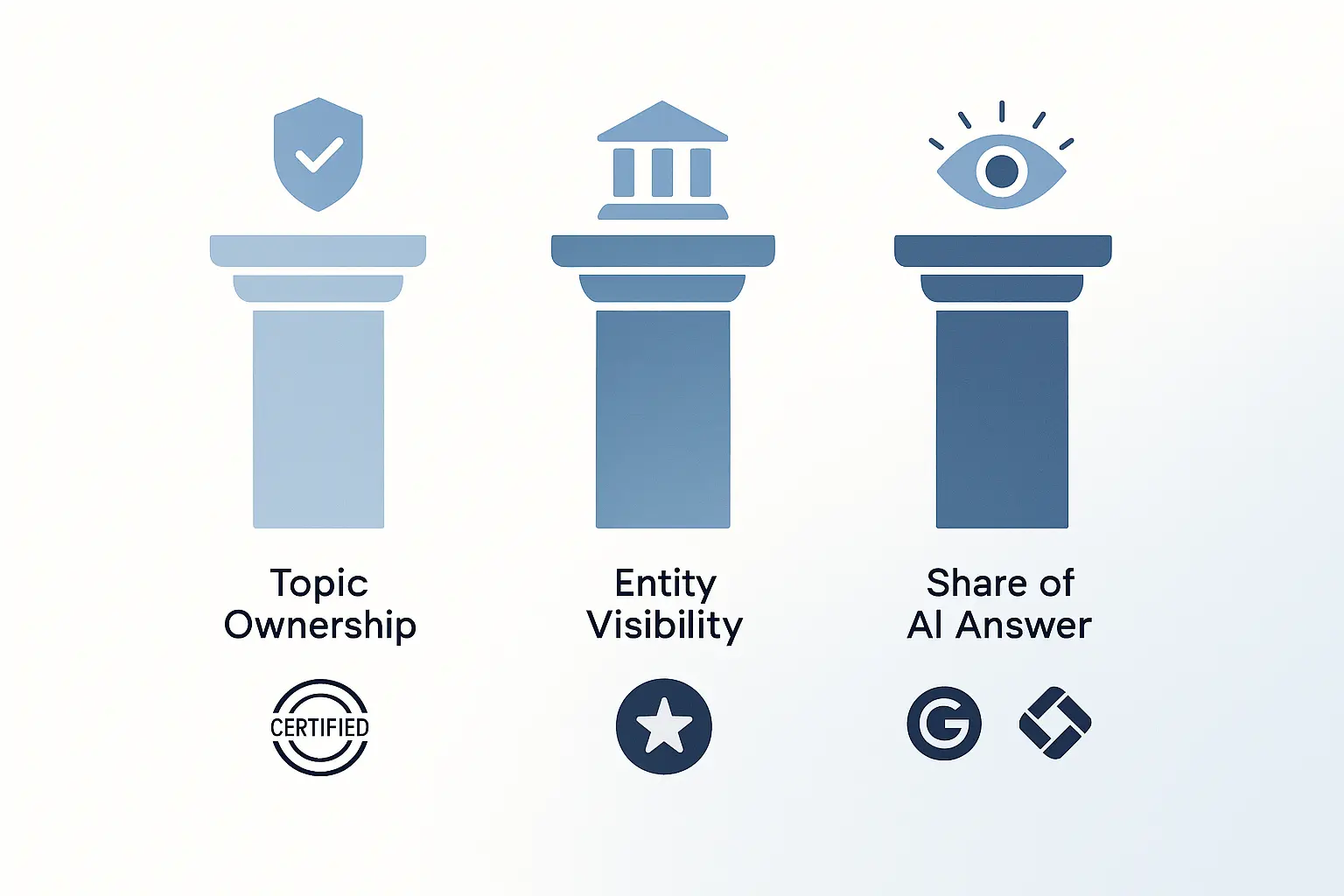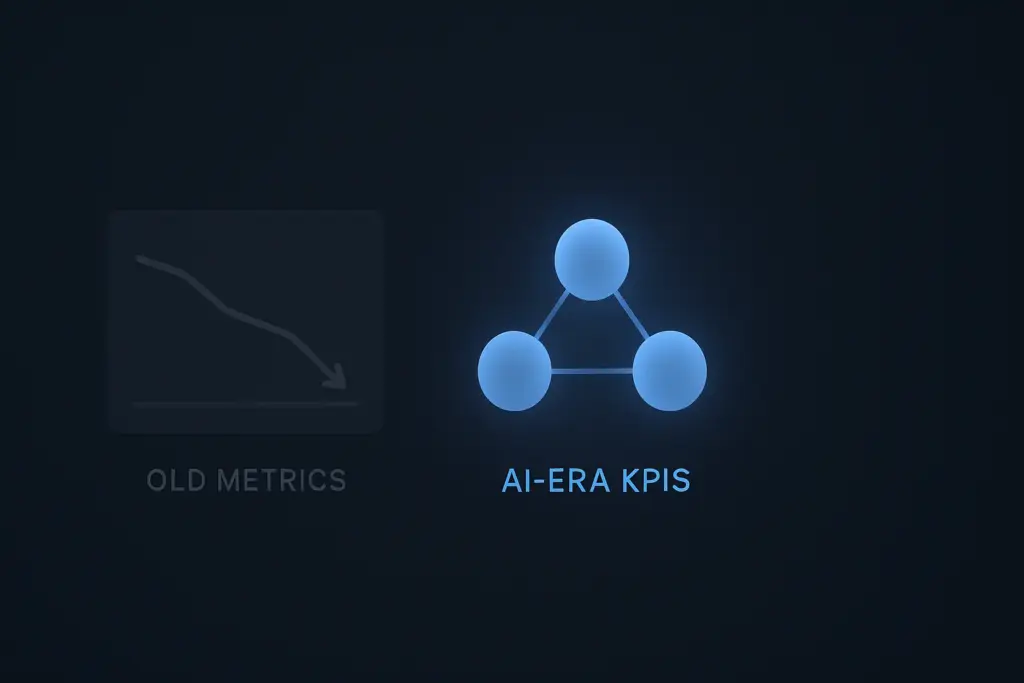Is your agency ready to answer when a client asks, “Our traffic is down, but you’re telling me our SEO is working?”
This is no longer a hypothetical scenario; it’s the new reality. Gartner predicts that organic search traffic will plummet by 25% by 2026, largely due to the rise of AI Overviews and generative search experiences. For agencies that have built their value proposition on delivering clicks and rankings, this is a reporting crisis in the making.
The traditional SEO dashboard is quickly becoming a relic. While still foundational, legacy metrics no longer tell the whole story. Relying on them is like navigating a new city with an old map—you’ll get somewhere, but probably not where you need to be.
Your agency’s opportunity isn’t to fight this change, but to lead clients through it. It’s time to evolve your reporting from a rearview mirror of past performance to a forward-looking measure of influence and authority. This guide provides the framework to make that happen.
Part 1: The Old Guard – Why Legacy Metrics Are Losing Their Power
For years, guides from industry leaders like Backlinko and Ahrefs have rightfully championed metrics like organic traffic, keyword rankings, and backlink velocity. These KPIs built the foundation of SEO reporting, and they still have their place.
- Organic Traffic: The total number of visitors from search.
- Keyword Rankings: Your position for specific search terms.
- Click-Through Rate (CTR): The percentage of people who see your site and click.
- Backlinks: The number and quality of links pointing to your site.
These metrics were effective because they were a direct proxy for visibility and engagement in a world of ten blue links. But AI-driven search is fundamentally changing user behavior. AI Overviews answer questions directly in the SERP, absorbing clicks and making “position zero” the new “position one.”
The result? Your client’s rankings might be stable, or even improving, yet their traffic could still decline. If your reporting doesn’t account for this, you risk looking ineffective when you’re actually building significant brand authority where it now matters most: inside the AI’s answer. With 84% of SEOs reporting that AI has already impacted their strategy, the need for a new measurement model is undeniable.
Part 2: The New KPIs – A Future-Proof Framework for SEO Success
To prove your value in the AI era, you need to shift from measuring traffic to measuring influence. This requires a new set of KPIs built on three pillars: Authority, Trust, and Visibility. These metrics gauge not just your presence in the search results, but how much the search engine trusts you as a definitive source.
Metric 1: Topic Ownership (The Authority Metric)
In the past, we chased individual keywords. Today, we need to own entire topics. Topic Ownership measures your brand’s share of the conversation for a whole subject area, not just a single query. When Google sees you as an authority on a broad topic, it’s far more likely to use your content to formulate its AI-generated answers.
- What it is: A measure of your visibility across a comprehensive cluster of related keywords and questions that define a topic.
- How to measure it:
- Topic Share: Use tools like Semrush or Ahrefs to define a list of 50-100 keywords for a core topic. Track your aggregate visibility and share of voice for that entire keyword basket over time. An increase in Topic Share means you’re becoming the go-to resource.
- Topical Coverage: Audit your content against a hub-and-spoke model. How many relevant sub-topics have you covered with in-depth content? A higher percentage of coverage signals greater authority.
Metric 2: Entity Visibility (The Trust Metric)
Google’s algorithms are increasingly focused on entities—the real-world people, places, and things behind a brand. Entity Visibility measures how well Google understands and trusts your brand as a credible entity. Strong entities are cited more often in Knowledge Panels and AI Overviews because they are seen as reliable sources.
- What it is: The strength and clarity of your brand’s identity within Google’s Knowledge Graph.
- How to measure it:
- Knowledge Panel Presence: Track how often your brand’s Knowledge Panel appears for branded and non-branded searches.
- Unlinked Brand Mentions: Monitor for mentions of your brand name across the web, even without a hyperlink. These mentions act as citations that reinforce your entity’s authority.
- Schema Markup Accuracy: Regularly audit the accuracy and completeness of your Organization and other relevant schema markup. Think of this as your direct line for feeding Google structured information about your entity.
Metric 3: Share of AI Answer (The Visibility Metric)
This is the “ranking” of the AI era. Share of AI Answer, also called citation frequency, measures how often your website is cited as a source within Google’s AI Overviews for your most important commercial queries. This is the ultimate proof that your content is authoritative enough to power Google’s own answers.
- What it is: The percentage of times your domain is featured as a source in AI Overviews for a target set of queries.
- How to measure it:
- Manual Tracking: For your top 10-20 bottom-of-funnel queries, perform manual searches weekly or bi-weekly. Record whether your site is cited in the AI Overview. A simple spreadsheet can track your citation frequency over time.
- Emerging Tools: Keep an eye on SEO tool providers, as automated tracking for this metric is becoming more common.
Adopting this three-pillar framework moves your agency’s reporting from a conversation about traffic to a strategic discussion about building a brand asset that can withstand any algorithmic shift.

Part 3: Reporting for the AI Era – How to Connect New KPIs to Client Revenue
Introducing new metrics is only half the battle. You have to connect them to what your clients care about most: growth. The key is to build a narrative that shows how building authority and trust leads directly to business outcomes, even if traditional traffic fluctuates.
Your new report should tell a story:
“This quarter, we increased your Topic Ownership for ‘financial planning for small businesses’ by 35%. This signals to Google that you are a definitive authority.”
“As a result, we’ve seen a 50% increase in Entity Visibility, with your brand’s Knowledge Panel now appearing for key informational queries.”
“This combination of authority and trust has led to a 20% Share of AI Answer for critical buying-intent keywords like ‘best small business retirement plan,’ placing your brand directly in front of qualified customers at the point of decision.”
This narrative reframes the value of SEO. It’s no longer just about driving clicks; it’s about influencing customers and embedding your brand into their decision-making journey before the click even happens.

From Reporting Metrics to Proving Your Value
The shift to AI-driven search represents the most significant challenge to SEO reporting in a decade. Agencies that cling to old metrics will struggle to justify their value, while those who embrace a new framework will position themselves as indispensable strategic partners.
Focusing on Topic Ownership, Entity Visibility, and Share of AI Answer allows you to confidently demonstrate your impact on a client’s business, build a more resilient SEO strategy, and lead the conversation about what success looks like in the future of search. This isn’t just about new columns in a spreadsheet; it’s about a new way of thinking.
Ready to equip your agency with the strategy and execution needed to deliver these next-generation results? Our white-label SEO execution model allows you to focus on client strategy while we handle the complex work of building authority in the background.

Frequently Asked Questions
1. How do I explain this shift to a client who only cares about traffic and leads?
Frame it as an evolution in how customers find businesses. Start by acknowledging the importance of traffic and leads, then introduce the Gartner statistic. Explain that since fewer people will be clicking, you’re focusing on two things: capturing the high-intent traffic that remains and influencing the majority of users who get their answers from AI. Position the new metrics as leading indicators of future revenue and brand recall.
2. Are traditional metrics like traffic and rankings completely useless now?
Not at all. They are still important pieces of the puzzle, but they are no longer the entire puzzle. Think of them as foundational metrics. Traffic from organic search is still highly valuable, and rankings are a prerequisite for being included in AI answers. They simply need to be reported alongside the new KPIs to provide a complete and accurate picture of performance.
3. Do I need expensive new tools to track all of this?
You can start tracking these new KPIs today with a combination of existing tools and smart processes. Topic Share can be measured using features already in Semrush and Ahrefs. Entity Visibility can be tracked via Google searches and free brand monitoring tools. Share of AI Answer can start with a simple manual tracking spreadsheet for your most valuable queries. As your process matures, you can explore more advanced solutions.
4. How does JVGLABS help agencies implement this new reporting framework?
We act as your invisible execution team, focused on the specific activities that improve these new KPIs. While your agency manages the client relationship and strategy, we work in the background on the technical SEO, content optimization, and authority-building campaigns designed to boost Topic Ownership, Entity Visibility, and Share of AI Answer. Our AI-powered automation and reporting systems are built to track and showcase these future-proof metrics under your brand.


